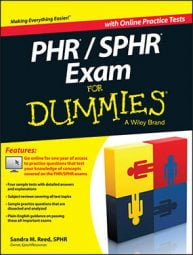The human resource management plan is part of the overall project management plan. This is an important document to know for the PMP Certification Exam. It has three main components:
Roles and responsibilities
Project organization charts
Staffing management plan
Human resource management plan. A component of the project management plan that describes how the roles and responsibilities, reporting relationships, and staff management will be addressed and structured.
Staffing management plan. The component of the human resource plan that describes when and how project team members will be acquired and how long they will be needed.
You can distribute roles and responsibilities to team members along with a RAM so that all team members can see specifically how they contribute to the project as well as how their roles interface and collaborate with other roles on the team.
The project organization chart should show the hierarchical relationship and reporting structure of team members on the project.
The staffing management plan covers issues associated with staffing the project. It can include sections on
Staff acquisition: How team members will be brought onto the team. For example, you might use different methods for bringing on team members, depending upon whether they’re employees or contractors. Part of staff acquisition is determining how to orient new team members. Also, consider whether staff will be co-located in one location or remotely.
Resource calendars: The number of labor units a team member or a group of team members will be working. The calendar can show hours in a week, days in a month, or whatever time scale is appropriate to the project. You can create a resource histogram that shows whether specific resources, or groups of resources, are over-allocated during any time period.
Staff-release plan: How team members will be released when their work is complete. The plan should address how to maintain the knowledge that the team member developed.
Training needs: Are any specific licenses, skills, certificates, or other training needed for the project? If so, you should develop a plan that demonstrates how to accomplish this.
Recognition and rewards: How you motivate and recognize outstanding achievements and reward team members throughout the project.
Recognition and rewards can be good for team morale. You should recognize outstanding achievements and reward team members throughout the project. Take time during planning to set the criteria and timing for formal rewards and recognition. In addition, consider the factors that motivate team members. Here is a list of common motivators that you should keep in mind.
Being appreciated: Whether you deliver the thank-you in person, or with a written note and a Cc to their boss and their personnel file, people are motivated when they know their work is appreciated.
Recognition: Taking time in the team meeting to recognize excellent work is a nice way to recognize team members. It is even better if their boss or the sponsor is present.
Rewards, awards, and prizes: Such incentives can be as simple as company logo-wear or a gift certificate to more substantial monetary awards.
Safety and compliance: Are there safety or other compliance regulations that need to be met and documented as part of the project? If so, document the strategy for conforming to the regulations.

